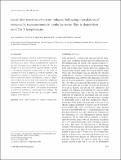| dc.description.abstract | The first visible response in livestock to the bite of a trypanosomeinfected
tsetse fly is the formation of a localized skin reaction,
also known as a chancre. This is an inflammatory response in
the skin associated with swelling and an influx of cells. It is
thought to be associated with an acquired immune response
to the injected metacyclic trypanosomes. In this study, we
examined the role of T lymphocytes in the development of the
inflammatory response, by depleting cattle of T cell subpopulations
and monitoring the development of chancres. Depletion
of CD4 cells, but not CD8 cells, resulted in a significant
reduction in chancre formation, confirming that an acquired
response mediates the inflammatory response. In addition, it
was established that the CD4 T cells mediate the generation
of memory for immunity to a homologueous re-challenge. The
inflammatory response in the skin did not affect further
progress of the infection. | en_US |

